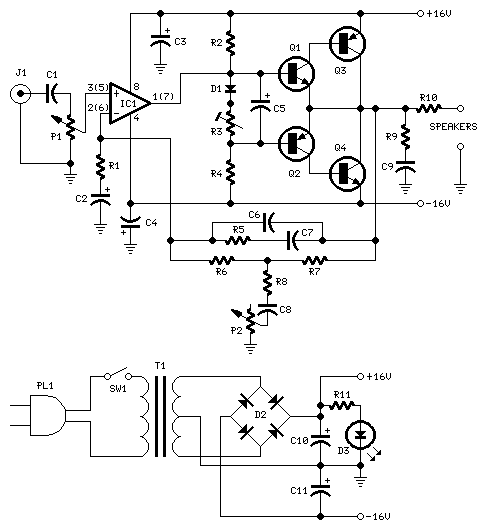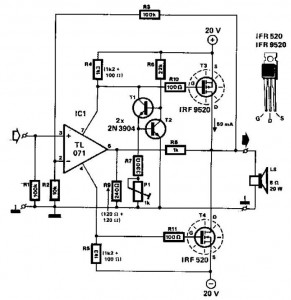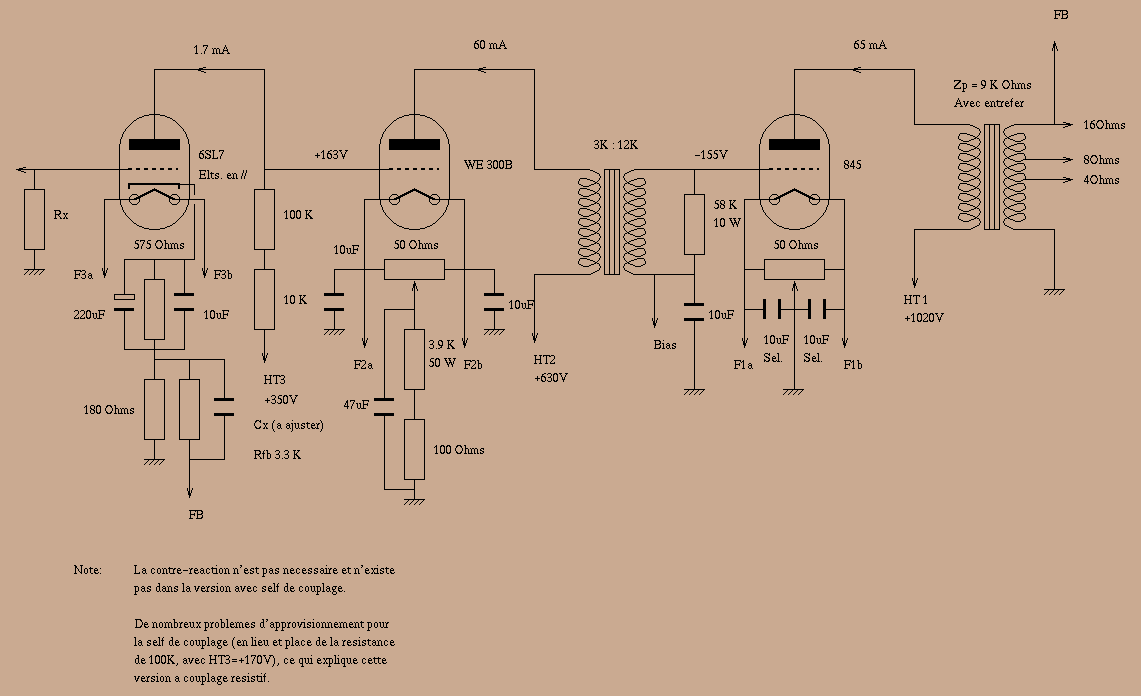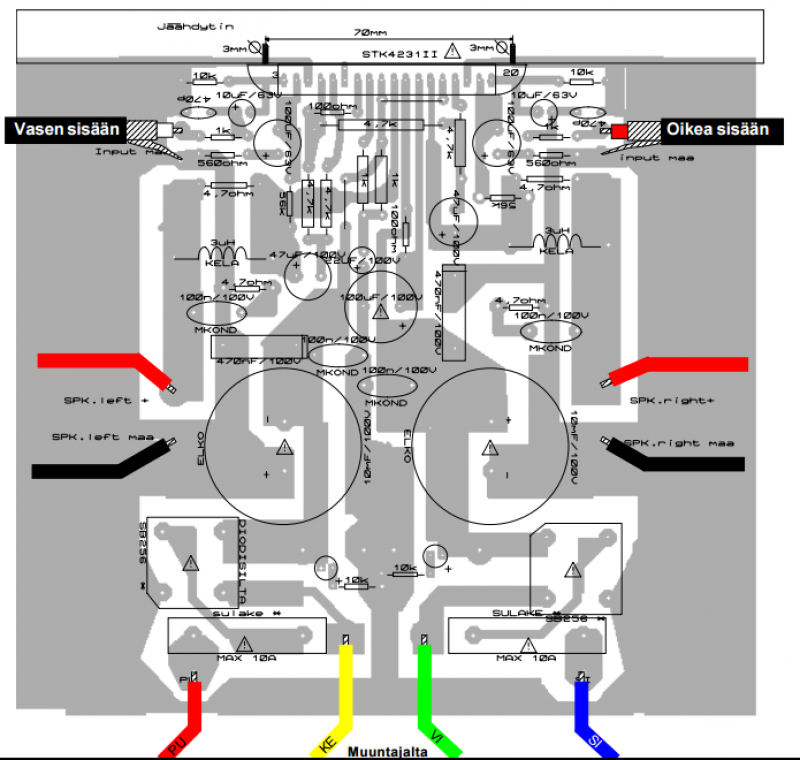
20W 40-500kHz PA 01
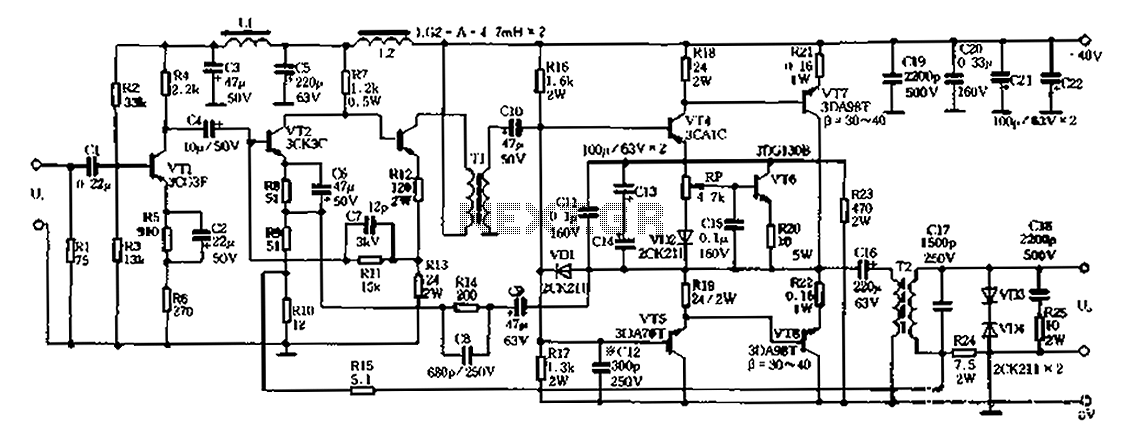
A 20W power amplifier circuit is illustrated in Figure 8-3. It features a pre-release level and enhances the power level through three stages to minimize significant phase shifts in the feedback loop. PNP silicon transistors are selected for both the feedback loop and the pre-release level. The preamplifier stage is designed as a single-stage common-emitter amplifier (VT1), with resistor R6 providing a series of negative feedback. This configuration ensures the stability of the operating point while also increasing the input impedance, allowing for stable input impedance during gain adjustments. The drive class 6 configuration connects each tube emitter directly through local negative feedback. The amplifying circuit is formed by transistors VT2 and VT3, with resistors R11 and R13 providing parallel voltage negative feedback to maintain a constant output signal level and gain. The output stage is coupled to the power amplifier stage via transformer T1.
The 20W power amplifier circuit is designed to deliver substantial output power while maintaining signal integrity and stability across various operating conditions. The architecture comprises multiple stages, each serving a distinct purpose in the amplification process. The initial stage, featuring the common-emitter configuration of transistor VT1, is crucial for achieving the desired pre-amplification. The inclusion of negative feedback through resistor R6 not only stabilizes the operating point but also enhances the overall input impedance, which is vital for interfacing with various signal sources.
Following the preamplifier stage, the circuit transitions into the drive class 6 configuration, where each transistor emitter is coupled through local negative feedback. This design choice minimizes distortion and improves linearity, essential characteristics for high-fidelity audio applications. The amplifying stage, consisting of transistors VT2 and VT3, is further optimized by resistors R11 and R13, which implement parallel voltage negative feedback. This feedback mechanism is instrumental in ensuring that the output signal level remains consistent regardless of variations in input signal amplitude or load conditions.
The final stage of the amplifier is the power amplifier stage, which is coupled to the preceding stages via transformer T1. This transformer plays a critical role in impedance matching and signal coupling, ensuring that the power amplifier can efficiently drive the load while maintaining the integrity of the amplified signal. Overall, the design of this 20W power amplifier circuit emphasizes stability, efficiency, and high-quality signal amplification, making it suitable for various applications in audio and signal processing systems.20W power amplifier circuit shown in Figure 8-3. It consists of a pre-release level, and promote the level of three parts p power level in order to reduce the large phase shift in the feedback loop, and promotion of pre-release level are selected PNP silicon tube. Preamplifier stage constituted by a single-stage common-emitter VT1 amplifier, R6 introduction of a series of negative feedback, both to ensure the stability of the operating point level, but also increase the input impedance. So that when adjusting the gain, input impedance of the circuit can be kept stable e drive class 6 each tube emitter coupled directly by the local negative feedback VT2, VT3 composed by the amplifying circuit and R11, R13 composed of parallel voltage negative feedback to ensure constant p of the output signal level of the stage work and gain points by the transformer Tl is coupled to the power amplifier stage.
The 20W power amplifier circuit is designed to deliver substantial output power while maintaining signal integrity and stability across various operating conditions. The architecture comprises multiple stages, each serving a distinct purpose in the amplification process. The initial stage, featuring the common-emitter configuration of transistor VT1, is crucial for achieving the desired pre-amplification. The inclusion of negative feedback through resistor R6 not only stabilizes the operating point but also enhances the overall input impedance, which is vital for interfacing with various signal sources.
Following the preamplifier stage, the circuit transitions into the drive class 6 configuration, where each transistor emitter is coupled through local negative feedback. This design choice minimizes distortion and improves linearity, essential characteristics for high-fidelity audio applications. The amplifying stage, consisting of transistors VT2 and VT3, is further optimized by resistors R11 and R13, which implement parallel voltage negative feedback. This feedback mechanism is instrumental in ensuring that the output signal level remains consistent regardless of variations in input signal amplitude or load conditions.
The final stage of the amplifier is the power amplifier stage, which is coupled to the preceding stages via transformer T1. This transformer plays a critical role in impedance matching and signal coupling, ensuring that the power amplifier can efficiently drive the load while maintaining the integrity of the amplified signal. Overall, the design of this 20W power amplifier circuit emphasizes stability, efficiency, and high-quality signal amplification, making it suitable for various applications in audio and signal processing systems.20W power amplifier circuit shown in Figure 8-3. It consists of a pre-release level, and promote the level of three parts p power level in order to reduce the large phase shift in the feedback loop, and promotion of pre-release level are selected PNP silicon tube. Preamplifier stage constituted by a single-stage common-emitter VT1 amplifier, R6 introduction of a series of negative feedback, both to ensure the stability of the operating point level, but also increase the input impedance. So that when adjusting the gain, input impedance of the circuit can be kept stable e drive class 6 each tube emitter coupled directly by the local negative feedback VT2, VT3 composed by the amplifying circuit and R11, R13 composed of parallel voltage negative feedback to ensure constant p of the output signal level of the stage work and gain points by the transformer Tl is coupled to the power amplifier stage.
